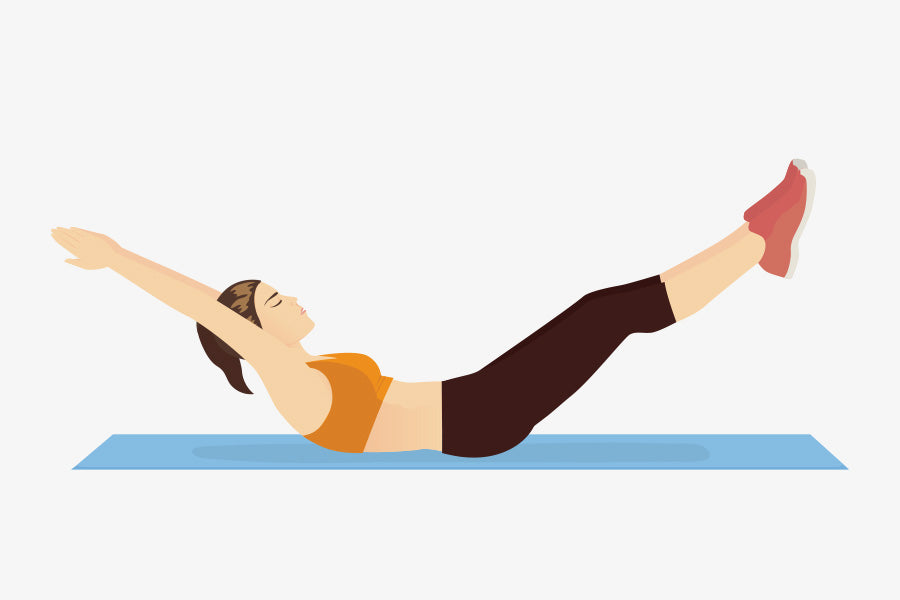Do you want a strong and defined core? Start incorporating isometric exercises into your routine! One of my favorites is the hollow hold.
Today, we're going to learn how to do a hollow hold. This isometric core exercise strengthens the abdominals and tones the abs. It's a great exercise to add to your routine if you're looking for a challenging way to work your core. So let's get started!
What is a Hollow Hold?
An isometric exercise, a hollow body hold, involves contracting your core muscles while keeping your body stationary.
- Start by lying down on your back flat on the floor.
- Bring your arms up overhead, raise your shoulder blades off the ground, and lift your lower body off the floor with a posterior pelvic tilt.
- Keep a strong core as you hold yourself in this position for the desired time.
Hollow holds seem very simple, but they can be difficult to do initially. They'll be especially challenging for those doing them for the first time. For the hollow body hold, it'll be wise to begin with 2-3 sets and 20-60 seconds per set. The number of sets and length of each one should be based on your ability to maintain good technique during the entire exercise.
Hollow Body Hold Muscles Worked
The hollow body hold is an excellent way to work your core muscles. This move primarily targets the rectus abdominis, the muscle that runs along the front of your stomach, and the obliques- the muscles on either side of the waist.
In addition, this move engages and strengthens the stabilizing muscles of the hip- hip flexors and glutes. You can effectively curb back pain issues by having a strong core and stabilizing muscles in adjacent areas.
Hollow Body Hold Vs. Front Plank: What's the Difference?
The hollow body hold and the front plank are excellent exercises for building core strength. However, they target different muscle groups and offer different benefits.
- The hollow body hold is primarily an abs exercise that works your hip flexors and erector spinae muscles. It works the rectus abdominis, the muscle that gives you a six-pack.
- On the other hand, the front plank targets the entire core, including the obliques and transverse abdominis. It also builds your arms and shoulders, which hollow holds miss.
How to Do a Hollow Body Hold With Perfect Form?
For the hollow body hold, perform 2–3 sets of 20–60 seconds. Choose your sets and duration of holds based on your ability to maintain good technique throughout each set.
- To begin, lie flat on your back with both arms extended overhead.
- Next, raise your arms and shoulders until they're no longer touching the ground--be sure to keep breathing!
- Finally, keeping your legs together, point your toes away from you and lift them a few inches off the ground.
- Hold your chin as if you were cradling an egg underneath it, and keep your pelvis slightly tucked. Your upper back, arms, and legs should all stay off the ground while your abdominal area (core) remains down.
- Activate your core muscles and keep the rest of your body tight.
- Maintain the position for as long as you desire.
Related Article: 15-Minute Core Slider Workout Plan | Incorporating Sliders Into Your Workout Routine
Hollow Body Hold Benefits
Seemingly very simple hollow holds are very promising. Here are some important benefits of hollow holds.
The hollow body hold can increase your overall strength, especially in the muscles in front of your body. These include core muscles like the rectus abdominis and transverse abdominis.
Also, hollow body holds are versatile and great for at-home workouts because they don't require equipment. If you want to increase the challenge, try holding dumbbells, kettlebells, or pilates rings while completing the exercise.
Hollow holds are one of the most important exercises to improve your functional core strength. Not only are hollow holds great for building overall stability in the spine, but they can also help progress your calisthenics training as you move up to more advanced skills.
The main benefit of the hollow hold is that it helps develop improved spinal stability. Improved spinal stability means better postural control, which will help protect your back from injury and make everyday movements easier.
Plus, strengthening your spine through hollow holds will bring more balance to those muscles surrounding it (think abs, glutes, and hip flexors).
By working on hollow holds regularly, you'll increase the range of motion in your hips and improve your ability to perform more advanced calisthenics movements, like handstands and planks variations.
Improved spinal stability will also help you progress into exercises requiring strength and control, such as levers and human flags.
Related Article: 10 Best Pilates Ring Exercises to Strengthen Your Core, According to Experts
Common Mistakes
The hollow body hold is a deceptively simple exercise that uniquely challenges your core muscles. The movement's goal is to maintain an isometric contraction for a specific period, and form is critical to ensure you get the most out of the move.
Here are some common mistakes people make when performing the hollow body hold:
Not Pressing the Lower Back Into the Ground
The key to this movement is to keep your lower back firmly against the ground by engaging your core. If you lose that connection with the floor, try readjusting your arm and leg positioning.
Something as simple as holding your arms down by your sides or bending your knees can help take some of the strain off your abs.
Keeping the Shoulder Blades on the Floor
The hollow body hold requires you to raise your shoulder blades off the ground. If your core isn't contracted properly, it may be tricky to create enough space between your body and the floor — but don't worry, you only need a small amount of tension on your abs.
Tucking Your Chin
Don't strain your neck by tucking your chin to your chest. Not only is this bad for alignment, but it also lessens the tension in your abdominal muscles.
The Bottom Line
So, now that you know all about the hollow body hold and how to properly do it, give it a try! This exercise is great for beginners to intermediate-level athletes looking to improve their core strength. Remember to keep your back flat against the ground and your shoulders down as you move through the holds. If you're feeling pain in your lower back, stop and rest. As always, listen to your body and make sure you warm up before any type of workout!











